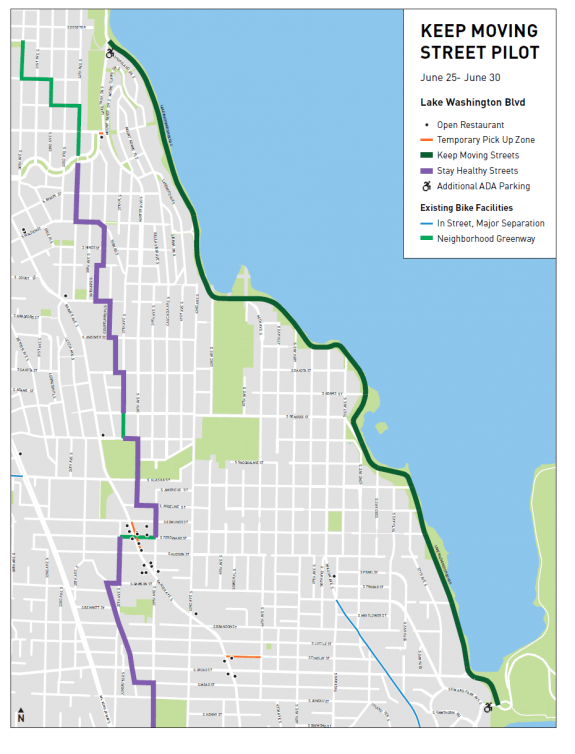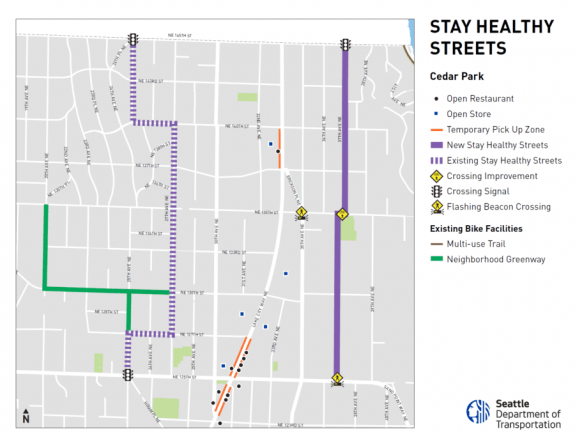 Lake Washington Blvd has been the most-requested street for the city’s car-free and car-light street projects, which started as a response to the COVID-19 outbreak and the need to create more space for people to safely distance while getting some exercise or fresh air. And now SDOT and Seattle Parks are experimenting with what is basically a five-day-long version of Bicycle Sunday, closing the street to cars between Seward Park and Mount Baker Beach.
Lake Washington Blvd has been the most-requested street for the city’s car-free and car-light street projects, which started as a response to the COVID-19 outbreak and the need to create more space for people to safely distance while getting some exercise or fresh air. And now SDOT and Seattle Parks are experimenting with what is basically a five-day-long version of Bicycle Sunday, closing the street to cars between Seward Park and Mount Baker Beach.
The pilot, dubbed a “Keep Moving Street” project, is among the city’s most ambitious projects yet. Unlike the city’s “Stay Healthy Streets,” which follow slow residential neighborhood greenway routes, Lake Washington Blvd is not a particularly low-traffic street, though nearly all homes and destinations have other route options. People can still drive on the street to access their homes and get deliveries, and people are already very familiar with how this works because Bicycle Sunday has been happening every summer for half a century. So there is a lot of community buy-in already.
The street is also a huge and, hopefully, high quality expansion of open space in south Seattle, where the city has long neglected to invest in safe streets and open public space. The existing walking path along the lake is far too skinny for people to pass each other while giving at least six feet of separation, so the open street provides that space.
@MayorJenny @seattledot thank you for opening this waterfront for people. Let's keep it this way! pic.twitter.com/983GMFFuec
— Anna Zivarts (@AnnaZivarts) June 26, 2020
Lake Washington Blvd is also part or the regional Lake Washington Loop bike route, a very popular route for regional and local bicycle recreation and transportation despite the fact that traffic can be very stressful on the street. There is no bike lane, and even though most people driving expect people to be biking there and give enough space when passing, there are always a few people who are either careless or cruel.
There has long been a need for safety changes to the boulevard, and hopefully this pilot can turn into something more permanent. The Bicycle Master Plan calls for painted bike lanes, but there is not room for bike lanes (and the road would need to be repaved since the road edges are deteriorating, money the city does not have in the budget). The only affordable way for bike lanes to work would be to make the street a one-lane or one-way street for general purpose traffic, using the other half of the street for bike lanes or a lakeside two-way bikeway. The street could also just become a permanent Stay Healthy Street. Or the city can use a mix of both ideas where appropriate.
 SDOT and Seattle Parks are also turning the forested and winding Golden Gardens Dr NW into a 24/7 Keep Moving Street until further notice. This street really does not serve much of a purpose for car travel so long as Golden Gardens Park remains closed to car parking to reduce crowding. And the main alternative for people walking down the steep hill is a skinny staircase without room for people to pass each other with enough space, so the added space should help. And the city is seeking feedback on the projects:
SDOT and Seattle Parks are also turning the forested and winding Golden Gardens Dr NW into a 24/7 Keep Moving Street until further notice. This street really does not serve much of a purpose for car travel so long as Golden Gardens Park remains closed to car parking to reduce crowding. And the main alternative for people walking down the steep hill is a skinny staircase without room for people to pass each other with enough space, so the added space should help. And the city is seeking feedback on the projects:
While Golden Gardens is 24/7 until further notice, Lake Washington Boulevard is a 5-day pilot to see if it might be worth extending the closure into the summer. Email [email protected] and let us know if people #KeepMoving, share the road well, and why or why not you’d like to see the closure extended throughout the summer.
You can also complete their online survey.
SDOT is also expanding is Stay Healthy Streets program, adding new routes in Wallingford and Cedar Park and extending the existing Beacon Hill route to connect from Georgetown to the I-90 Trail. This brings the total mileage to 27 miles of car-light streets.


![]() More details on the city’s process for making projects permanent and SDOT’s efforts to understand what “safe” means for everyone, including BIPOC who “do not always feel comfortable traveling along our streets due to racism”:
More details on the city’s process for making projects permanent and SDOT’s efforts to understand what “safe” means for everyone, including BIPOC who “do not always feel comfortable traveling along our streets due to racism”:
You may be asking what does permanent mean and how will streets be selected?
At the most basic level, it means installing permanent signs at each intersection. Treatments can vary depending if the location is a busy intersection, or if there are sidewalks.
Beyond that, we want to work with the neighborhood to understand how the streets could become part of the neighborhood character. This could be celebrating cultures that have been there over the decades, landmarks, bringing people together around street murals, and whatever else is highlighted as important through community discussions.
It also means everyone traveling along the street feels safe. People choose different travel modes depending on abilities and needs. Blacks, Indigenous people, and people of color do not always feel comfortable traveling along our streets due to racism. No matter where you live, or whether you use a Stay Healthy Street, help fight racism and become an ally and help make Seattle streets for everyone.
Take our online survey and tell us what your experiences with Stay Healthy Streets have been like, where you might like to see them become permanent, and help us form our community engagement plan to center equity. The survey will close on July 15.








Comments
11 responses to “SDOT pilots a car-free Lake Washington Blvd through Tuesday, announces more Stay Healthy Streets”
Lake Washington Boulevard is one of the most scenic drives in Seattle, especially in the late spring when the flowering cherries are in bloom. I don’t support making this a local access and bicycle/pedestrian only street. Everyone should be able to enjoy this area including those that can only access it by car. I would support changing it to a one way southbound street with the current northbound lane devoted to bicycles and pedestrians.
Same goes for Magnolia Boulevard West — should be accessible to everyone not just locals, bicycles and pedestrians. There’s really no traffic on this street so why close it to cars?
I like being able to walk along the waterfront, listening to the birds and waves without the constant roar of passing cars. The vast majority of cars have no reason to be there – they’re just cutting through, and have other routes available.
Perhaps a compromise is open up limited parking along the waterfront, just for cars with handicapped placards. That would allow people on wheelchairs to cruise up and down the waterfront without having to navigate hills in their wheelchair.
But, the moment you start allowing general cars to drive through, you’re going to get a ton of drivers cutting through for no reason other than some software algorithm on their phone deciding that it will save 30 seconds by skipping one stoplight.
” Everyone should be able to enjoy this area including those that can only access it by car.”
Right, but you can do that, even if they close the street to cars. It is really quite simple: drive your car. Park close to the street. Get out of your car. Walk or roll your wheelchair.
Maybe once the city makes the street local access only they could start a program where they open Lake Washington Boulevard to general automobile traffic on certain Sundays during the spring and summer. We could call it “Car Sundays”.
Or AAA could organize a special cars-only event every year. They could charge drivers who want to enjoy the beauty of the lake bike-free $50-75 for the event. It would have to start really early though so that the cars are all off of LWB by 11 am.
I love this idea! Thank you Steve! Open to cars for special events!
Steve, I nominate you for comment of the day, week, year? I love it. I was saddened to hear dear friends recently comment about feeling conflicted about Lake Washington Blvd not allowing car traffic; they’re car centric, own a classic Mustang, and enjoy cruising around. I get it. But while your suggestion may have been a touch facetious, I think it’s a brilliant counterpoint. Why not have the very occasional “car day”, and flip Bicycle Sunday on it’s head.
How do we get this idea promoted? I would vote for it, amazing idea.
The one way for cars sounds like a positive compromise to assure accessibility for all. The existing walking path is poorly maintained with tree roots bulging out of pavement, precluding bikes to use it safely. Plus, it is too narrow for two-way pedestrians, dogs and bikes to safely use it, especially during Covid. We’d love to see SDOT and the City to give greater, more equitable priority to the south end of Seattle for a change!
This is another dumb idea from our city government. Lake Washington is one of the most scenic and beautiful drives in the city. Why do you have to inconvenience everyone for the sake of a few bicycles?
Yes, I know it gives you a good feeling, but what bout everyone else?
Poe’s law.
Lake Washington Blvd was originally designed by the Olmsted’s (who also designed Central Park in NYC, as well as Volunteer Park on Capitol Hill) as a bicycle path. Let that sink in. Also, let me correct you — this wasn’t “another dumb idea from our city government.” This was thousands of your fellow residents organizing and making their voices heard. Until we did this, in fact, the one day a week during summer weekends that a portion of Lake Washington Blvd was closed to vehicle traffic was canceled by the city.
Let me rephrase your comment in my own words — Lake Washington Blvd is one of the most scenic and beautiful places to ride a bicycle in the city. It’s part of the tremendously popular Lake Washington Loop Trail. Why should bicyclists and pedestrians be made less safe by car drivers using Lake Washington as a bypass? Because residents and delivery trucks still have access in cars.
The reality is, you don’t have to drive it to enjoy Lake Washington Blvd during this pilot or if a Stay Healthy or one way drive solution is implemented. A stay healthy street does not in fact preclude ANYONE from enjoying it. Park your car, walk, wheel a wheelchair, ride a bike, sit on a bench, enjoy the lake, the trees, the clean air. Plus, as Steve suggested above, maybe an annual drive could be organized, or possibly a few weekends in the summer could allow motorized vehicles.